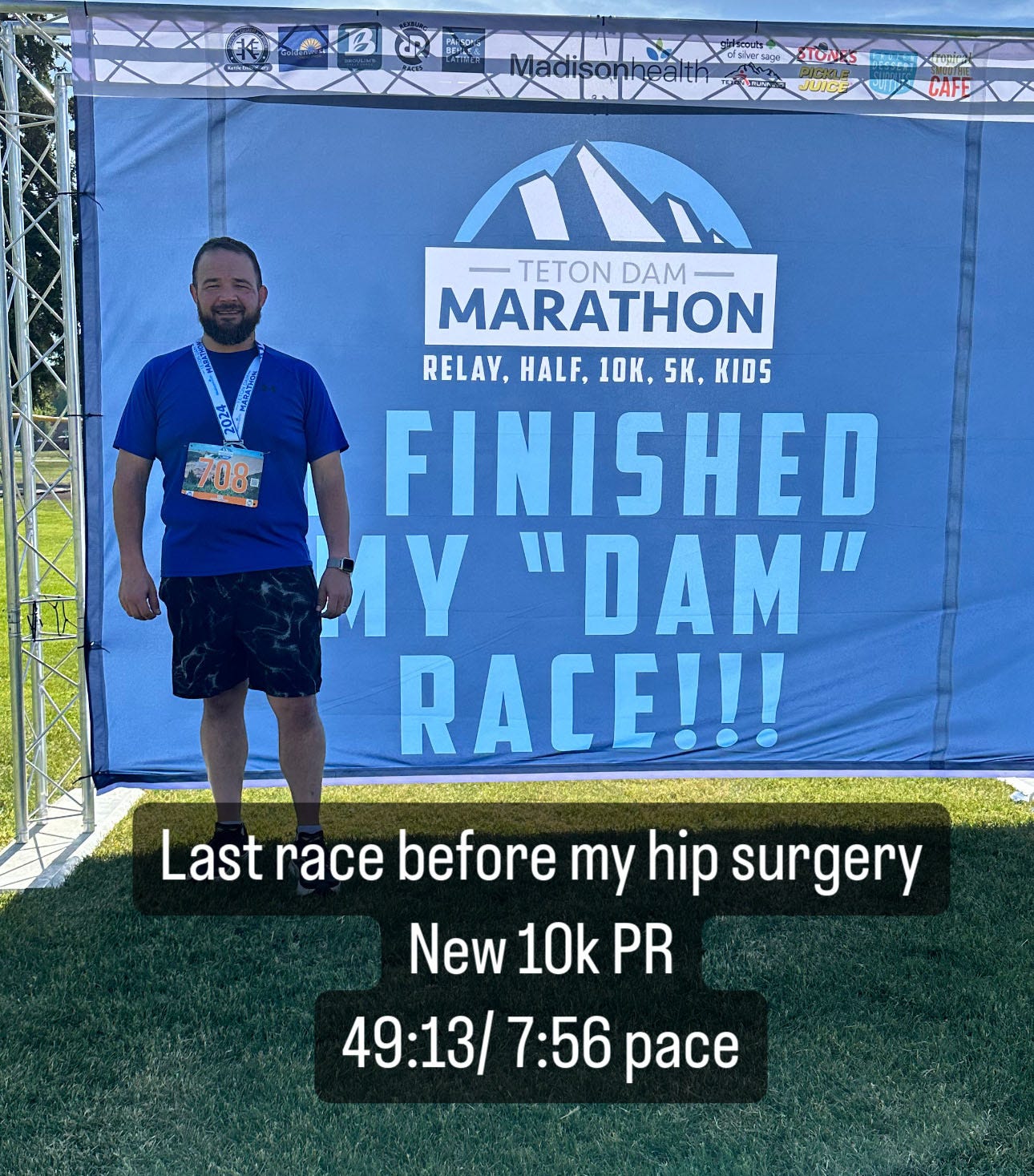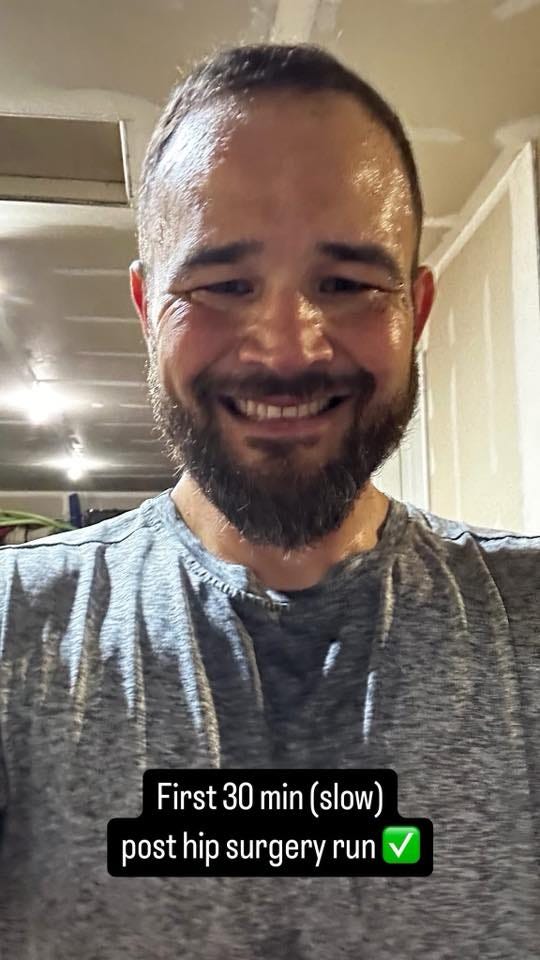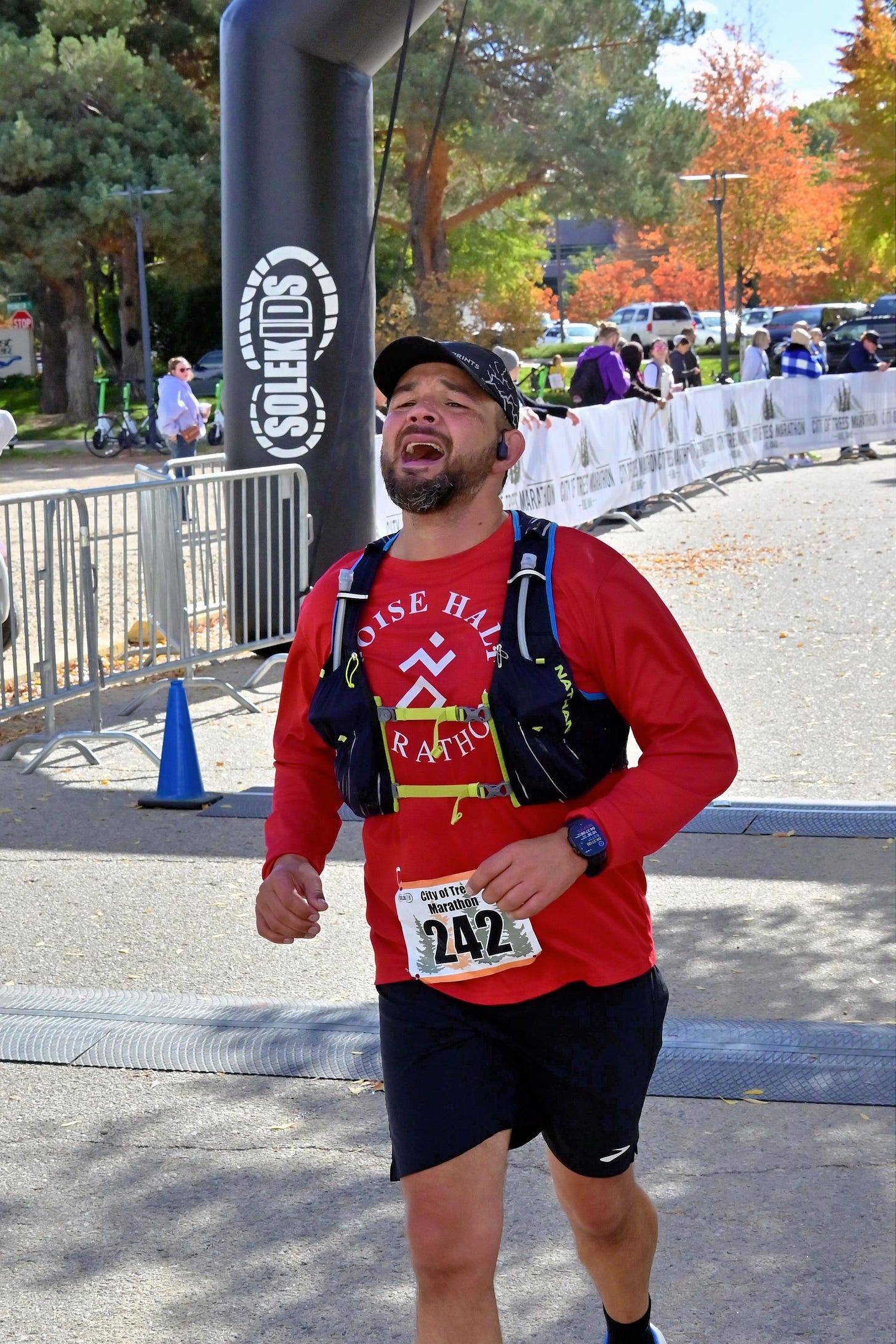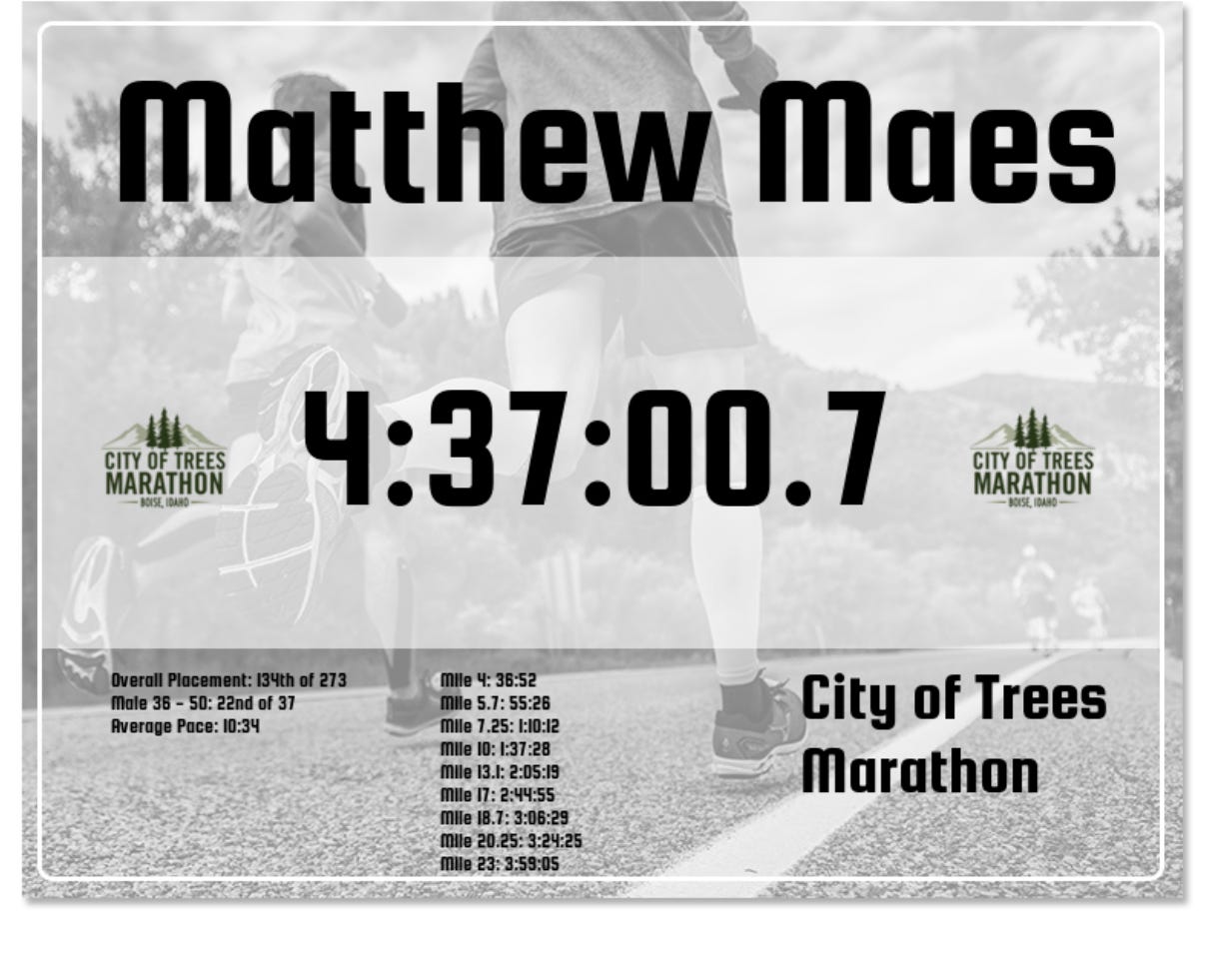The Shadow Side of Discipline
How Hip Surgery, Zepbound, and a Marathon Taught Me that My Worth is Not Measured by My Tools.
In the 19 months since I wrote my last article, I have achieved unprecedented success. I ran my first marathon, recovered from hip surgery, hit a 10K PR, and was promoted to CTO of my company.
Yet this success did not come without struggle: a wrestling match with the shadow side of discipline—a mental push to define my worth solely through the outcome of my journey, rather than the journey itself.
Despite all my inner work, I fell back into the trap of my own ego.
After losing 140 pounds, I went off the medication Mounjaro (Zepbound). I set out to prove to myself and to the world that I could do this without medication. For nearly a year, I maintained my weight loss without the aid of medication.
At the time, I didn’t realize that my quest to prove I didn’t need Zepbound was rooted in the core lie of my life: “I had to earn my right to exist through performance”. A childhood script that tied my self-worth and acceptance to achievement and results.
The paradox is that the tools I used to achieve success over the past year—weight loss medication, major hip surgery, and a grueling endurance test—became the exact crucible where I would see this lie at play and for what it was—a story “I” told myself, a story I get to rewrite.
Each of these achievements was not a victory of willpower but rather an act of surrender to a greater truth, a truth that taught me that my worth was never in question.
Through the crucible of marathon miles, I realized that I don’t have to prove anything to anyone, even myself. My choice to use Zepbound was irrelevant to my worth—it was merely a tool enabling me to live a fully embodied life on my terms.
1. The Great Surrender: Trading Grit for the Scalpel (Hip Surgery)
In the summer of 2023, my journey transitioned from weight loss to health and fitness. The previous year, my success metric had been easy: the scale was steadily decreasing, and all I had to do was look in the mirror and watch myself slowly transform. Now that the process had concluded, I knew I needed a new metric.
Since I was a young kid, I loved to run. Growing up, I would ride my bike or run with my dad while he was training. I ran my first 10k at 10 years old, the Boulder Boulder in Boulder, Colorado. But somewhere on the journey to 314 pounds, that joy, like many other things, had been lost. After losing the first 100 pounds, I rediscovered the freedom of running. Drawing on that powerful childhood memory and cultivating the joy it brought, it was clear to me that my new success metric would be running.
In October 2023, I ran my first post-weight-loss race, the Jackson Hole Quarter Marathon, followed by the Boise Half Marathon in November 2023. My new “Mountain in the Distance” became running a Marathon—I signed up for the “Boise River Marathon” in early May 2024.
Unfortunately, as my training increased, so did the pain in my hip. I tried everything I could to manage it, including gritting my teeth and pushing through—the Shadow Side of Discipline taking over.
Ultimately, in February 2024, after visiting the orthopedic specialist, I learned I might need a hip replacement, and I may never run again.
The diagnosis was a gut punch!
I found out I had severe osteoarthritis and a labral tear in my right hip, possibly requiring a joint replacement. Running was no longer a healthy option for me for the time being. My initial reaction was a bit of denial. I desperately tried to rationalize a way to keep running—my ego shouted to the universe, “I’ll show you I can run”, rather than face the shame of being unable to perform.
After a few days and after seeing the diagnosis on paper, I finally began to work towards acceptance of this new reality. One of the steps of acceptance was sitting with and labeling my fear.
“Without running, how will I sustain my motivation to be healthy—what if I regain all the weight I lost?”
This was when I saw my attachment to running and how I was making my happiness dependent on my ability to run. One of the most important lessons of my weight loss journey was when it became clear that happiness was not an outcome to achieve; it was a continuous byproduct of the journey itself.
Finding Conscious Discipline
This realization became the cornerstone of my practice of Conscious Discipline—that my worth was not tethered to a marathon goal, but to the daily, compassionate practice of showing up for myself.” My running injury reminded me why I started running in the first place. To be the healthiest version of myself.
It also showed me something important—I had become fixated on my marathon goal and kept running through my injury despite the risk to my health.
At some level, I had tied my happiness to reaching my goal of completing a marathon.
The Good News!
In March 2024, I saw a specialist at the University of Utah Orthopedics Center. He had the best news I could ever get. He could repair my hip without a replacement, and I would likely run again!
We scheduled the surgery for late June, and he told me in the meantime to continue to run within my pain tolerance. The three months leading to the surgery were some of the best runs I have ever had. The universe had taken away something I loved and then suddenly returned it—I ran with nothing but gratitude.
In June 2024, I ran the Teton Dam 10k, two weeks before the surgery. Knowing I had no control over the outcome of the surgery, I set the intention to run this race like it was the last race I would ever run—and because it was free of the burden of performance, I ran my 10k PR: 49 minutes and 13 seconds!
When I arrived for my hip surgery, I did so at complete peace with whatever outcome may come, even one that meant I could never run again.
2. The Lie of Willpower: My Fight to Prove I Didn’t Need Zepbound
In August 2023, my savings card for Mounjaro (Zepbound) expired. My endocrinologist had recommended the medication the year prior because of the combination of obesity, prediabetes, sleep apnea, and high blood pressure. Through a combination of alternate-day fasting, exercise, and Mounjaro, I had successfully lost 140 pounds in less than a year.
While on the journey, I joined a Facebook group with others who were also on Mounjaro for weight loss. One thing I saw that really bothered me was that many people called it their “liquid gold” and it was clear they were convinced that there was no way they could maintain their weight loss without Mounjaro. I could see clearly that they were “clinging” to their ability to have the drug, and it was causing suffering; suffering that I refused to create for myself.
However, I didn’t recognize my ego at play. Seeing their dependence also triggered my own internal shame, because it reflected the root of my Shadow Side’s fear: being fundamentally dependent and flawed.
When my card expired, I decided that I would be different, that I would show the world that you can lose weight with Mounjaro, go off the drug, and keep the weight off. Subconsciously, I tied the success of my entire heroic narrative to a single performance metric: proving my discipline was so pure, it didn’t need the tool.
For nearly a year, I successfully maintained my weight loss, hired a nutrition coach, and experimented with my fasting schedules. Externally, it looked like a highly successful transition, and it was; internally, it was exhausting, a highly pressurized experiment—a year of constantly micro-managing every input, a subconscious hum of perfectionist pressure. The Shadow Side kept the pressure at a relentless pitch, driven by the little voice that screamed: ‘Don’t fuck up. Don’t let your entire story become the proof of a fraud.” It would take the clarity gained from the surgery and the marathon ahead for me to see the power this voice held over me—the voice was the hum of performance anxiety itself, which proved my worth was irrelevant to the tool I chose.
As I sat motionless in recovery the week following the surgery, I had a powerful realization. I had built a health and fitness structure on three pillars: Mindset, Movement, and Fuel. A core pillar, movement, was completely taken away for 30 to 45 days and would not be fully restored for at least 4 months. I felt out of control; The surgery had exposed my ego's perfectionism at play. In the space of this awareness, I was presented with a choice: surrender or potentially regain the weight I had worked so hard to lose.
Later that week, I met with my endocrinologist. He strongly recommended I go back on Zepbound. Sitting with my options, the choice was clear—I would rather go back on Zepbound and continue living life on my terms than succumb to the consequences of my ego’s drive for perfection.
3. The Crucible of Consciousness: The Marathon
For the next eleven months, I slowly recovered from my hip surgery. With the aid of Zepbound and alternate-day fasting (36 hours), I lost the post-surgery weight and continued to maintain my weight loss. As my physical therapist told me, I had to “earn the right to run again” by completing the post-surgery recovery plan.
In late October 2024, I had my first, really slow 30-minute run. Over the next seven months, I built my running base.
Towards the end of May 2025, I committed to running the City of Trees Marathon in Boise, Idaho, on October 11. Typically, I would immediately sign up and pay for the race, locking myself into the goal. This time, I consciously paused that habit. I committed to the training while, simultaneously committing to not running the marathon if, deep in my heart, my body told me it was not a healthy decision. The goal was the process, not the finish line.
As my training progressed, so did the miles and time of the “long run”. During a two to three-hour run, there is plenty of time to ponder and explore the deepest recesses of my mind. At one point, I found myself asking, “Do I actually enjoy this?” I couldn’t find a word, only a feeling, that can most accurately be described as “fulfillment”. It also became clear that enjoyment is not black-and-white.
It dawned on me that in the long run, I get to intentionally step into a dark cloud—the chaos of my past and my mom’s alcoholism, the shadow of my own fear. During the run, I’m not running from the feeling. I’m not trying to escape it. I’m moving towards it. I’m running through it. I’m transcending it. Through this process of running through and transcending that dark shadow of my mom’s alcoholism (the fear I carried within myself), I am giving myself the love and clarity I craved as a kid.
As race day approached, my true task became clear: it was not to achieve a time, but to maintain presence. I shifted my marathon intention from focusing on a finish time to the meaning I placed in the entire experience itself: my personal rite of passage, an integration of seven years of personal growth work and healing.
It would be my Crucible of Consciousness.
Despite all my inner work, the ego found its way back into the driver’s seat.
Even though my body told me a four-and-a-half-hour marathon was my realistic goal, my ego wanted to listen to my training plan, which had me finishing in sub-four hours. My ego dreamed of “bragging rights” for running my first marathon under four hours. I started the race with a plan to run a 9:20 pace for 10 miles, 9:05 for 10, and then under 9 minutes for the last six miles. It was the ultimate pacing error—my shadow side’s last stand, hijacking my pace in one last attempt at a performance goal.
The Inner Duel: The Test of Presence
Past mile 13, the price of my pacing error began to play out in my body. Each mile that followed, my pace crept towards my body’s realistic marathon pace, somewhere around 10:30. Interestingly, it was at mile thirteen that I would have my first mental test—I had expected to see my dad at the halfway point, cheering me on. Passing the halfway point, he was nowhere to be seen. My heart sank.
In that sinking moment, I chose to look inward, giving my inner child the emotional affirmation I had been seeking from the external world. I didn’t need the validation; I was the sovereign source of my own comfort. A few short miles later, I passed the apartment I lived in after college. Running by, I looked at the parking lot, which was one of the last places I saw my mom alive—the spot I had to send her away, setting one last boundary with her alcoholism, my heart sinking as I watched her drive away.
At that place, I let the full emotion of the experience wash over me, bringing its dark cloud into the run. I didn’t run from it; I ran through it, transcending the trauma with each forward footstep, until I could finally see the highest version of my mom in the distance, cheering me on.
The next few miles took me through the section of the Boise Greenbelt where my grandfather did his morning walk every day up until his battle with cancer. It was here that I found myself calling upon his strength, which had been the pillar of stability growing up with my mom’s alcoholism.
As the miles got tougher and tougher and my mind wanted to take me to some other place, I repeated the mantra of my training miles, “come back to now Matt”. This was the practice of Conscious Discipline I had created for myself during the long months of training, where I proved I could survive the chaos of the long run without resorting to control or quitting.
Approaching Mile 21—now deep in the six most brutal miles of the marathon—I saw my dad waiting for me. It was the lift I needed, but unlike Mile 13, his presence was a bonus, not a requirement. I had already affirmed my worth, and now his support became the final push I needed to declare: no matter what, I am finishing this marathon.
The Final Quarter-Mile: The True Finish Line
As I approached the final quarter-mile of the race, having survived the six most brutal miles on inner grit and sheer consciousness, my mother-in-law, father-in-law, and my son were waiting to give me one last cheer and encouragement. As I passed by, my son, who absolutely hates running, decided to run me in. He ran by my side in flip flops, telling me, “You got this, Dad. I believe in you”.
At this point, I was physically and emotionally raw, and my son’s act of love broke me open.
Reflecting on my marathon, I realized I didn’t run over 500 miles to prepare for a marathon; I ran all those miles—the culmination of seven years of personal growth work—to be ready for that most important quarter-mile with my son. He unknowingly, in that moment, became my greatest teacher, showing me what an act of pure affirmation, rooted only in love and free of the need for approval, looked like.
4. The New Blueprint: Discipline as Self-Care
The true victory of my marathon was not my 4 hour and 37 minute finish time. It was the life lesson of Conscious Discipline—cultivated over four and a half months and 500 miles of training—that my worth is a given, the starting point for all things. My happiness is not the outcome of my actions, but a direct result of the moment-to-moment presence I bring to them.
The past 19 months served as a reminder that the trap of the ego is inevitable. The real shift is in how I play the game of life.
The Old Game
The old paradigm meant playing “How do I not fall into the trap of my own ego?”—a game designed for failure that only fed the exhaustive perfectionism (the hum).
The New Game
The game is not avoiding the trap, but defining the response when the trap inevitably springs: “How quickly can I become aware of my ego at play and respond to that part of me with presence and love?”
This begins with a combination of mental and physical awareness: noticing the subtle hum of pushing in my mind and the sensation of clenching tension in my body, particularly in my legs. My job is not to squash that part of me and make it go away; my job is to pause, take a deep breath, and get curious about why the buzzing and tension are there in the first place.
Because these triggers hold the gold that will lead to my next moment of growth and acceleration towards my purpose.
Closing Thoughts: A Meditation on Healing
Journal Entry: What Does It Mean To Heal? (Circa 2022)
What does it mean to heal?
I used to think healing meant that I would fix what was wrong with me. That after I healed, I would be perfect, my life would be perfect. I would be happy.
Today, I believe that we are never truly healed. To be healed would be something in the past; hence, I wouldn’t be experiencing it right now. As soon as I declare I’m healed, I’m done with it and am therefore no longer healed—I was healed.
I think we are always healing because healing isn’t a destination; it’s a lifelong journey. A journey of continuously looking at what is inside, right now, and showing a willingness to unpack what is there and experience it. There will always be triggers and internal conflicts; healing is a process of learning to accept them and learning to work with them rather than living life in spite of them.
Don’t get me wrong, there was a moment in my healing journey where there was a shift in my being. A change in perspective where my past and my wounding no longer owned me. If I were reading my story before it was written, I would have perceived this as the moment I was fixed.
“Fixed” was as far from the truth as I could ever be, as it was the moment I fully embraced the parts of me that I perceived as needing fixed, taking complete ownership of them. It was an act of surrender to what it is. If my life were a picnic and what I perceived as needing fixed was the rain, this was the moment I made the choice to have the picnic in the rain. Feeling each drop of water as it fell upon me, and choosing to savor the flavors of the picnic basket of life, rain or shine.
This was the moment I took ownership of my story, my emotions, and my life…
As powerful as this moment was, it was also rather insignificant. It was just one moment in time, preceded and followed by many others. Without the continuous moments of choosing to take ownership of my life right now, over and over, that moment would be meaningless. Like the first breath after a breath hold, if I hold on to it forever, I am not breathing, I am not living.
When I take ownership of my life, I view every day as an opportunity to take ownership of my emotions, to respond to and work with my triggers in new and more effective ways. I don’t reject the internal conflict within; I embrace it and view it as a teacher. A guide pointing me in the direction of my purpose. I view every day as an experiment that informs my next steps. I no longer seek perfection; I only seek what works.
I get to practice the art of healing, everyday.





